E-Verify Management for Small Businesses
Simplify your hiring with our managed E-Verify services. As an E-Verify Employer Agent, Milestone will help set up and maintain your account, process new hires to ensure compliance and simplify the complexity around employment eligibility.
- Simplified hiring
- Ensure compliance
- Reduce liability
Let Milestone be your partner in simplifying compliance so you can get back to what you do best – running your business.
Our Clients
Proud to partner with high growth businesses and nonprofits.
Understanding E-Verify: A Comprehensive Guide for Business Owners and Executives
Introduction
In today’s ever-growing automated and digital society, the onboarding process has become more efficient with the use of electronic systems like E-Verify. Launched by the Department of Homeland Security (DHS) in partnership with the Social Security Administration (SSA), its primary purpose is to ensure employees are legally eligible to work in the United States. Implementing E-Verify effectively can be a crucial element for strengthening your business’s compliance procedures.
E-Verify is of significant importance to both employers and employees as it simplifies the verification process and mitigates the risk of hiring ineligible employees. This article covers an in-depth examination of what E-Verify truly entails, spotlighting issues such as its mandatory status, the process of an E-Verify check, E-Verify requirements for employers, differences between E-Verify and I-9, and how employees can navigate the E-Verify landscape.
What Does E-Verify Do for Identity and Employment Eligibility Compliance?
At its core, E-Verify is an online tool that allows E-Verify employers to confirm the eligibility of their employees to work in the United States. The system cross-references the information provided by the employee on their Form I-9, Employment Eligibility Verification, against the databases of DHS and SSA.
The E-Verify check begins immediately after a completed Form I-9 is submitted. The E-Verify system compares the information to government records. If the information matches, the employee is eligible to work; if there’s a mismatch, a tentative non-confirmation (TNC) is issued, and the employee will have the opportunity to contest this.
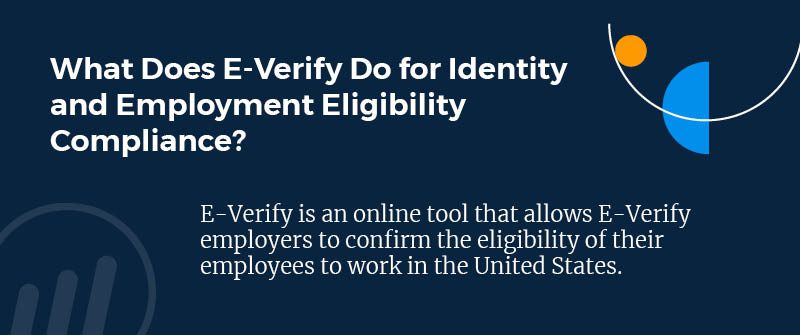
Is E-Verify Mandatory in the USA to Verify Employment Eligibility?
The answer depends on the nature and geographical location of your business. In general, participation in the E-Verify program is voluntary. However, certain federal contracts require E-Verify employer status, and numerous states have passed laws making E-Verify mandatory for some or all employers.
Which States Require E-Verify 2023?
As of 2023, there are different rules in different states for E-Verify use. For instance, Alabama, Arizona, Mississippi, and South Carolina require all employers, public and private, to use E-Verify. Whereas some other states require its implementation only for public employers or contractors.
It’s also important to be aware of recent changes and updates in state requirements. Always stay current with your state’s specific E-Verify requirements to avoid any legal fallout.Understanding E-Verify Requirements
Federal requirements for E-Verify mandate that all information from the employee’s Form I-9 be entered into the system no later than the third business day after the employee starts work. Also, federal law prohibits the use of E-Verify on potential employees – it can only be used after hire.
E-Verify employers have an obligation to notify each job applicant of their participation in the E-Verify process and use the system responsibly and in accordance with the law. Failure to do so may lead to penalties, including termination of their E-Verify access.
Are I9 and E-Verify the Same Thing?
While Form I-9 and E-Verify both play a crucial role in employment eligibility verification, they are not the same. The Form I-9 process necessitates the collection of personal identifying information and unexpired documents from the employee to confirm their identity and eligibility to work.
The E-Verify, on the other hand, is used following the completion of Form I-9, where it matches the information from the form with government databases, ensuring the veracity of the documents. Unlike the form I-9 process, E-Verify provides confirmation of employment eligibility.
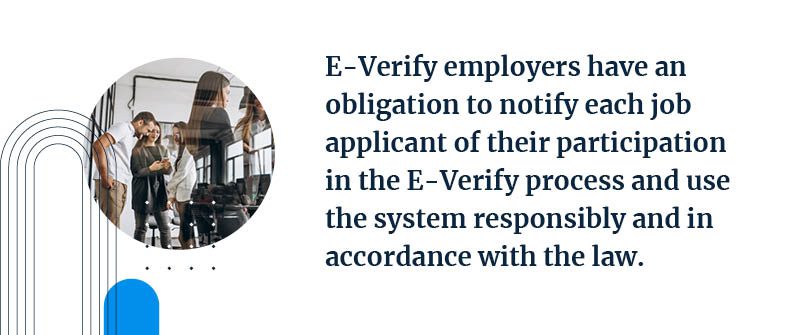
E-Verify for Employers
Enrollment as an E-Verify employer primarily involves a few steps, including creating an account, signing a memorandum of understanding, and completing an online tutorial. From then on, employers can run the verification process for each new hire.
The best practices for E-Verify compliance incorporate timely attention to TNC cases, confidentiality, transparency, non-discriminatory practices, and adherence to guidelines for storing and disposing of personal employee information.
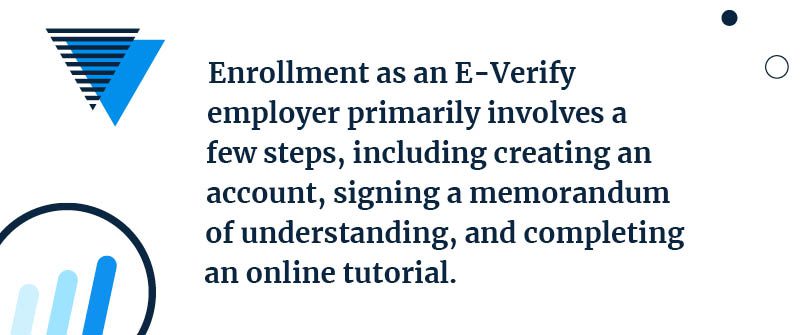
E-Verify for Newly Hired Employees
Both new and existing employees should be aware that the E-Verify check is initiated only after they have accepted a job offer and completed the Form I-9. They have the right to contest a TNC and should contact DHS or SSA if a case of discrimination is suspected.
E-Verify Customer Service
E-Verify customer service is accessible for employers to receive guidance or aid concerning the system. Various resources available include a customer support hotline, e-mail support, tutorials, user manuals, checklists, and fact sheets.
Case Studies and Examples of E-Verify in Action
The use of E-Verify has a bearing across various industries and sizes of E-Verify companies. It’s more commonplace in heavily regulated industries, among large corporations, and is gradually gaining traction in smaller businesses striving for best compliance practices.
Real-life implications for meeting E-Verify requirements range from avoiding penalties to elevating the business image for conscientious compliance with labor laws, thereby attracting quality employees.
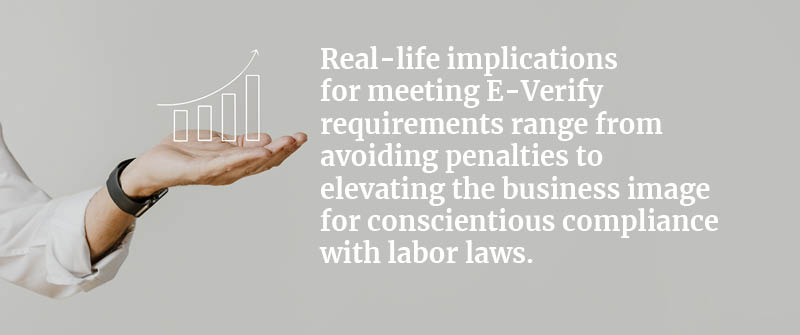
Addressing Common Misconceptions and FAQs on E-Verify
There are various misconceptions regarding E-Verify, such as it being a background check or that it screens out illegal immigrants, which is false. E-Verify solely confirms employment eligibility based on government databases.
Looking Ahead: The Future of E-Verify
In the near future, it’s plausible that more regulations mandating the use of E-Verify may be implemented as the government grapples with undocumented work. As this happens, the role of E-Verify in the job market and its implications on employment will become increasingly significant.
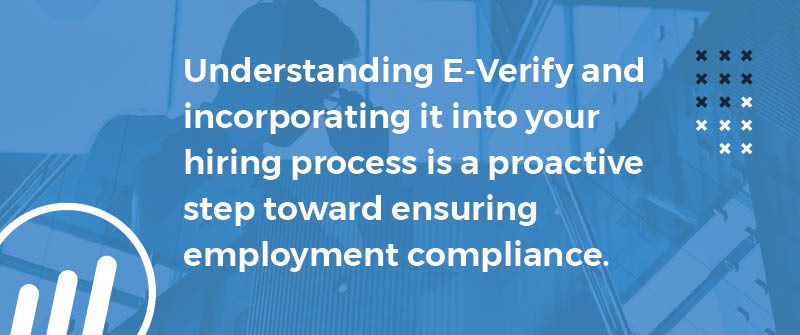
Conclusion
Understanding E-Verify and incorporating it into your hiring process is a proactive step toward ensuring employment compliance. It’s not only a crucial means of verifying legal work status but also a step towards fair and ethical recruitment in the wake of growing emphasis on workers’ rights.
How Milestone Can Help
At Milestone, we can help by ensuring that you are compliant with E-Verify requirements and by managing the service as an Employer Agent. There are significant fines for illegally employing workers and using E-Verify can reduce your liability and show that you made a good-faith effort to have compliant hiring practices. Additionally, utilizing E-verify allows employers to take advantage of the alternative document inspection procedures. This means employees can present documents electronically via live video call instead of requiring an in-person inspection. This is all permitted if the company participates in E-Verify.
Get Started!
Transform your accounting into a competitive advantage.